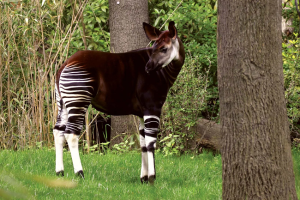Have you ever wondered if an animal could be so interesting that it seems like it is from a storybook? Imagine this: deep inside Africa’s lush forests lives an animal so fascinating that it almost feels made up. The Okapi, a unique and endangered creature, has amazed nature lovers.

Let’s take a journey to learn about the Okapi, discover its secrets, understand the challenges it faces, and see the important work being done to protect it.
The Okapi (Okapia johnstoni), often referred to as the “forest giraffe” or the “zebra giraffe”, is a species that combines the grace of a gazelle with the allure of a zebra, a fascinating creature that seems to have been plucked straight out of a storybook.
Despite its ancient origins, this elusive mammal was only discovered by scientists in the early 20th century. Its distinctive markings and natural defenses against predators have helped it survive in the wild, even though it is notoriously difficult to observe. The okapi is so highly regarded in the Democratic Republic of Congo that it is considered a national and cultural symbol and has been protected for nearly a century.
Standing approximately 4.9-6.6 feet (1.49-2m) tall at the shoulder, okapis possess a slender build perfectly suited for navigating their dense forest habitat. What truly sets them apart, however, is their striking coat pattern.
Their deep brownish-red fur is adorned with crisp, horizontal white stripes on their legs, resembling zebra stripes. This distinct camouflage helps them blend seamlessly into their environment, effectively avoiding predators and human observers.
But the Okapi’s mystique goes beyond its appearance. Its large, rounded ears swivel like radar dishes, picking up even the faintest sounds of approaching danger. They have a long, flexible tongue, similar to that of a giraffe, allowing them to reach foliage that is out of reach for many other herbivores and groom themselves.
They have the ability to consume toxic leaves, fruits, and fungi. However, they have developed a unique adaptation by consuming charcoal and clay, which helps absorb the toxins and provides additional minerals for their diet. Similar to their giraffe cousins, the okapi also splay their legs to drink.
Habitat, Range & Population
To truly understand the Okapi, one must venture deep into the heart of the African rainforest.
These creatures inhabit the Ituri and Aruwimi forests in the northeastern region of the Democratic Republic of Congo. The dense foliage, lush undergrowth, and ample water sources provide the perfect sanctuary for these remarkable animals.
Unfortunately, their exclusive range makes them exceptionally vulnerable. As human populations expand and forests are cleared for agriculture and logging, the Okapi’s habitat diminishes, pushing these elusive creatures to the brink of extinction. This is further compounded by illegal hunting, driven by the demand for their striking pelts and meat, as well as the capture of young Okapi for the illegal pet trade.
Okapi, previously believed to be abundant in its forest habitat, has experienced a significant decrease in population over the years. Current estimates suggest that only approximately 10,000 to 15,000 individuals remain in the wild, and this number continues to decline and is currently Endangered, according to the IUCN Red List. This decline is concerning and highlights the pressing importance of conservation initiatives to safeguard these remarkable animals.
Conservation Efforts: A Ray of Hope for the Okapi
Thankfully, there are dedicated organizations and individuals working tirelessly to protect the Okapi and its habitat.
One such organisation is the Okapi Conservation Project (OCP), which has been at the forefront of Okapi conservation for over three decades. OCP focuses on habitat protection, anti-poaching efforts, community engagement, and scientific research to ensure the survival of the Okapi.
Anti-poaching teams patrol the forests to deter illegal hunting and protect these beautiful animals. Community engagement is another critical aspect of Okapi conservation. OCP collaborates with local communities to develop sustainable livelihoods that reduce the pressure on the Okapi’s habitat while promoting their conservation.
Furthermore, scientific research plays a vital role in understanding Okapi behavior, ecology, and health. This knowledge informs conservation strategies and helps protect these elusive animals more effectively.
A Brighter Future for the Okapi
While the challenges are tough for Okapi, there is a small light of hope ahead. The hard work put into protecting them is starting to pay off, giving us reason to believe these wonderful creatures will keep roaming the rainforests of the Democratic Republic of Congo for many years.
As passionate admirers of wildlife, it falls upon us to amplify the Okapi’s story, to stand shoulder-to-shoulder. Together, we can become the guardians of these endangered beings, preserving the spellbinding biodiversity that thrives within our planet’s rainforests. Let us not forget our shared responsibility to safeguard and nurture these extraordinary creatures for generations yet to come.
The Okapi’s tale is a poignant reminder that, armed with dedication, passion, and collective determination, we can ensure that Earth’s most remarkable inhabitants remain a cherished part of our planet’s vibrant tapestry of life.
By Assaf Levy
